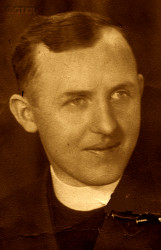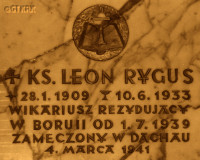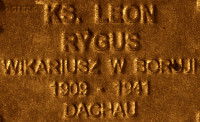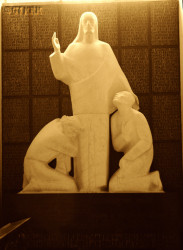Roman Catholic
St Sigismund parish
05-507 Słomczyn
85 Wiślana Str.
Konstancin deanery
Warsaw archdiocese, Poland
full list:
displayClick to display full list

searchClick to search full list by categories
wyświetlKliknij by wyświetlić pełną listę po polsku

szukajKliknij by przeszukać listę wg kategorii po polsku

Martyrology of the clergy — Poland
XX century (1914 – 1989)
personal data
surname
RYGUS
forename(s)
Leo (pl. Leon)
function
diocesan priest
creed
Latin (Roman Catholic) Church RCmore on
en.wikipedia.org
[access: 2014.09.21]
diocese / province
Gniezno and Poznań archdiocese (aeque principaliter)more on
www.archpoznan.pl
[access: 2012.11.23]
date and place
of death
04.03.1941

KL Dachauconcentration camp
today: Dachau, Upper Bavaria reg., Bavaria state, Germany
more on
en.wikipedia.org
[access: 2016.05.30]
details of death
After German and Russian invasion of Poland in 09.1939 and start of the World War II, after start of German occupation, arrested by the Germans on 27.01.1940.
Interned in IL Lubin transit camp in Lubiń.
On 24.05.1940 transported to KL Dachau concentration camp.
Next on 02.08.1940 transported to KL Gusen I concentration camp — part of KL Mauthausen‐Gusen concentration camps' complex — where slaved in quarries, among others.
From there on 08.12.1940 — totally exhausted and gravely sick — brought back to KL Dachau concentration camp where soon perished.
There are indication that he might have become a victim of murderous so‐called „medical experiments” — Germans apparently „shortened several of his ribs”.
According to the death certificate, prepared in KL Dachau, the „honest” otherwise German „medical doctors” and formalists — and at the same time, unrivaled fairy tale spinners — noted that the cause of death was Germ. „Versagen von Herz und Kreislauf” (Eng. „Heart and circulatory failure”).
prisoner camp's numbers
11400, 22001Click to display source page (KL DachauClick to display the description)
cause of death
extermination: murder / exhaustion / disease
perpetrators
Germans
sites and events
Medical experimentsClick to display the description, KL DachauClick to display the description, KL Gusen IClick to display the description, KL Mauthausen‐GusenClick to display the description, IL LubinClick to display the description, 02‐03.1940 arrests (Warthegau)Click to display the description, Reichsgau WarthelandClick to display the description, «Intelligenzaktion»Click to display the description, Ribbentrop‐MolotovClick to display the description, Pius XI's encyclicalsClick to display the description
date and place
of birth
28.01.1909Birth certification on:
photos.szukajwarchiwach.gov.pl
[access: 2025.09.08]

Lesznotoday: Leszno city pov., Greater Poland voiv., Poland
more on
en.wikipedia.org
[access: 2021.07.18]
parents
RYGUS Anthony
🞲 ?, ? — 🕆 ?, ?

DRGAS Apolonia
🞲 ?, ? — 🕆 ?, ?
presbyter (holy orders)
ordination
10.06.1933

Poznańtoday: Poznań city pov., Greater Poland voiv., Poland
more on
en.wikipedia.org
[access: 2021.07.18]
St Peter and St Paul the Apostles RC archcathedral churchmore on
en.wikipedia.org
[access: 2025.03.14]
positions held
1939 – 1940
vicar — Zbąszyńtoday: Zbąszyń gm., Nowy Tomyśl pov., Greater Poland voiv., Poland
more on
en.wikipedia.org
[access: 2021.06.20] ⋄ Blessed Virgin Mary of the Assumption RC parish ⋄ Zbąszyńtoday: Zbąszyń gm., Nowy Tomyśl pov., Greater Poland voiv., Poland
more on
en.wikipedia.org
[access: 2021.06.20] RC deanery — resident in Boruja Kościelna
1939
administrator — Sarnowatoday: district of Rawicz, Rawicz gm., Rawicz pov., Greater Poland voiv., Poland
more on
en.wikipedia.org
[access: 2022.02.03] ⋄ St Andrew the Apostle RC parish ⋄ Krobiatoday: Krobia gm., Gostyń pov., Greater Poland voiv., Poland
more on
en.wikipedia.org
[access: 2021.07.18] RC deanery
till 1939
vicar — Sarnowatoday: district of Rawicz, Rawicz gm., Rawicz pov., Greater Poland voiv., Poland
more on
en.wikipedia.org
[access: 2022.02.03] ⋄ St Andrew the Apostle RC parish ⋄ Krobiatoday: Krobia gm., Gostyń pov., Greater Poland voiv., Poland
more on
en.wikipedia.org
[access: 2021.07.18] RC deanery
from 1934
vicar — Murowana Goślinatoday: Murowana Goślina gm., Poznań pov., Greater Poland voiv., Poland
more on
en.wikipedia.org
[access: 2021.07.18] ⋄ St James the Great the Apostle RC parish ⋄ Murowana Goślinatoday: Murowana Goślina gm., Poznań pov., Greater Poland voiv., Poland
more on
en.wikipedia.org
[access: 2021.07.18] RC deanery
1933 – 1934
vicar — Parzęczewotoday: Kamieniec gm., Grodzisk Wielkopolski pov., Greater Poland voiv., Poland
more on
en.wikipedia.org
[access: 2021.12.18] ⋄ St Michael the Archangel RC parish ⋄ Grodzisk Wielkopolskitoday: Grodzisk Wielkopolski gm., Grodzisk Wielkopolski pov., Greater Poland voiv., Poland
more on
en.wikipedia.org
[access: 2021.07.18] RC deanery
1930 – 1933
student — Poznańtoday: Poznań city pov., Greater Poland voiv., Poland
more on
en.wikipedia.org
[access: 2021.07.18] ⋄ philosophy and theology, Archbishop's Theological Seminary (Collegium Leoninum)
till 1930
student — Gnieznotoday: Gniezno urban gm., Gniezno pov., Greater Poland voiv., Poland
more on
en.wikipedia.org
[access: 2021.12.18] ⋄ philosophy, Archbishop's Theological Seminary
others related
in death
ANDRZEJCZAKClick to display biography Stanislav Kostka, BUKOWYClick to display biography Stanislav, DACHTERAClick to display biography Francis, FELCZAKClick to display biography Stanislav, GLISZCZYŃSKIClick to display biography Francis, JANECKIClick to display biography Mieczyslav, KAŁUŻAClick to display biography Joseph Marian, KŁOCZKOWSKIClick to display biography Mieczyslav John, KOCOTClick to display biography Joseph Francis, KOŁODZIEJClick to display biography Stanislav, KONOPIŃSKIClick to display biography Marian Vaclav, KULASIŃSKIClick to display biography Leo, LEŚNIEWICZClick to display biography Louis, LIGUDAClick to display biography Paul Louis, LISClick to display biography Thomas, ŁAGODAClick to display biography Leo, NOWICKIClick to display biography Casimir Alphonse, PAJDOClick to display biography Francis, SEJBUKClick to display biography Ceslav, SEWIŁŁOClick to display biography Stanislav, STABRAWAClick to display biography Joseph, STACHOWSKIClick to display biography Bruno, STOPCZAKClick to display biography Marian Conrad, TRZASKOMAClick to display biography John, ZUSKEClick to display biography Stanislav Witold
sites and events
descriptions
Medical experiments: Criminal medical experiments conducted by German specialists on concentration camp inmates. Among tests, in KL Dachau, KL Auschwitz, KL Buchenwald and other camps, performed by German murderers were malaria injections, liver tests, injections of tuberculosis, typhoid, phlegmon germs, flying tests (in pressure chambers), blood crystallization and coagulation tests, hypothermia, sterilization, starvation tests, etc. (more on: pl.wikipedia.orgClick to attempt to display webpage
[access: 2012.11.23], en.wikipedia.orgClick to attempt to display webpage
[access: 2013.12.04])
KL Dachau: KL Dachau in German Bavaria, set up in 1933, became the main German Germ. Konzentrationslager (Eng. concentration camp) KL for Catholic priests and religious during World War II: On c. 09.11.1940, Reichsführer‐SS Heinrich Himmler, head of the SS, Gestapo and German police, as a result of the Vatican's intervention, decided to transfer all clergymen detained in various concentration camps to KL Dachau camp. The first major transports took place on 08.12.1940. In KL Dachau Germans held approx. 3,000 priests, including 1,800 Poles. The priests were forced to slave labor in the Germ. „Die Plantage” — the largest herb garden in Europe, managed by the genocidal SS, consisting of many greenhouses, laboratory buildings and arable land, where experiments with new natural medicines were conducted — for many hours, without breaks, without protective clothing, no food. They slaved in construction, e.g. of camp's crematorium. In the barracks ruled hunger, freezing cold in the winter and suffocating heat during the summer, especially acute in 1941‐1942. Prisoners suffered from bouts of illnesses, including tuberculosis. Many were victims of murderous „medical experiments” — in 11.1942 c. 20 were given phlegmon injections; in 07.1942 to 05.1944 c. 120 were used by for malaria experiments. More than 750 Polish clerics where murdered by the Germans, some brought to TA Hartheim euthanasia centre set up in Schloss Hartheim in Austria and murdered in gas chambers. At its peak KL Dachau concentration camps’ system had nearly 100 slave labour sub‐camps located throughout southern Germany and Austria. There were c. 32,000 documented deaths at the camp, and thousands perished without a trace. C. 10,000 of the 30,000 inmates were found sick at the time of liberation, on 29.04.1945, by the USA troops… (more on: www.kz-gedenkstaette-dachau.deClick to attempt to display webpage
[access: 2013.08.10], en.wikipedia.orgClick to attempt to display webpage
[access: 2016.05.30])
KL Gusen I: German Germ. Konzentrationslager (Eng. concentration camp) KL „Grade III” (Germ. „Stufe III”), part of KL Mauthausen‐Gusen complex, intended for the „Incorrigible political enemies of the Reich”. The prisoners slaved at a nearby granite quarry, but also in local private companies: at SS guards houses' construction at a nearby Sankt Georgen for instance. Initially opened in 05.1940 as the „camp for Poles”, captured during the program of extermination of Polish intelligentsia («Intelligenzaktion»). Till the end most of the prisoners were Poles. Many Polish priests from the Polish regions incorporated in the Germany were brought there in 1940, after start of German occupation of Poland, from KL Sachsenhausen and KL Dachau concentration camps. (more on: en.wikipedia.orgClick to attempt to display webpage
[access: 2014.03.10])
KL Mauthausen‐Gusen: A large group of German Germ. Konzentrationslager (Eng. concentration camp) KL camps set up around the villages of Mauthausen and Gusen in Upper Austria, c. 30 km east of Linz, operational from 1938 till 05.1945. Over time it became of the largest labour camp complexes in the German‐controlled part of Europe encompassing four major camps concentration camps (KL Mauthausen, KL Gusen I, KL Gusen II and KL Gusen III) and more than 50 sub‐camps where inmates slaved in quarries — the granite extracted, previously used to pave the streets of Vienna, was intended for a complete reconstruction of major German towns according to the plans of the chief architect of National Socialist Germany, the Germ. Generalbauinspektor für die Reichshauptstadt (Eng. General Building Inspector for the Reich Capital) and from 1942 also, i.a. the Germ. Reichsminister für Bewaffnung und Munition (Eng. Reich Minister for Armaments and Ammunition), Albert Speer — munitions factories, mines, arms factories and Me 262 fighter‐plane assembly plants. The complex served the needs of the German war machine and also carried out extermination through labour. Initially did not have a its own gas chamber and the intended victims were mostly moved to the infamous euthanasia center in the Schloss Hartheim castle w Alkoven, 40.7 km east, or killed by lethal injection and cremated in the local crematorium. Later a van with the exhaust pipe connected to the inside shuttled between KL Mauthausen and KL Gusen. In 12.1941 a permanent gas chamber was built. C. 122,000‐360,000 of prisoners perished. Many Polish priests were held, including those captured during the program of extermination of Polish intelligentsia («Intelligenzaktion»). The camp complex was founded and run as a source for cheap labour for private enterprise. (more on: en.wikipedia.orgClick to attempt to display webpage
[access: 2014.03.10])
IL Lubin: The Gestapo District Office in Poznań issued on 13.12.1939 executive instruction Ref. IIB No. 406/39 Tgb. No. 3045/39, ordering: „Based on the regulation of the Germ. Höherer SS‐ und Polizeiführer (Eng. Higher Commander of the SS and Police) [of the Germ. Warthegau (Eng. Greater Poland)] province of 12.11.1939 [SS‐Gruppenführer Wilhelm Koppe], apart from Poles and Jews, also Catholic clergy will be expelled. Action against this group of people should be carried out in such a way that internment and transport are separate […] C. 80% of Catholic clergy are expected to be expelled. The selection based on political threat posed. Internees cannot be placed in regular transit camps due to the possibility of international protest. Catholic clergy should be interned in men's monasteries and held there till mass transportation out”. And so at the Benedictine abbey in Lubiń near Kościan, at the beginning of 1940, the Germans — Germ. Geheime Staatspolizei (Eng. Secret State Police), i.e. Gestapo — organized an temporary Germ. „Internierungslager” (Eng. „Internment camp”) IL Lubin for priests and friars from Greater Poland (dated from 15.02.1940, although the Germans brought several priests to the abbey earlier). E.g. in 04.1941 Franciscan friars from Goruszki monastery were brought in. In total, 104 clergymen were held in the monastery. On 06.10.1941, as part of the third great operation of arrests of the Polish clergy of Greater Poland — more precisely, from the Germ. Warthegau occupational province — all interned priests were transported to the KL Dachau concentration camp. Religious brothers were allowed to return to their family homes. The monastery was turned into an old people's home, and later as a training center for national‐socialist German youth, Germ. „Hitler‐Jugend” (Eng. „Hitler youth”). Rich library collections and other goods were plundered. The Benedictines returned to the monastery on 25.01.1945, after the German defeat. (more on: www.benedyktyni.netClick to attempt to display webpage
[access: 2013.08.10], pl.wikipedia.orgClick to attempt to display webpage
[access: 2013.08.10])
02‐03.1940 arrests (Warthegau): First large wave of arrests of Polish Catholic clergy from German occupied Greater Poland region, transformed in to German province Germ. Reichsgau Wartheland (Eng. Greater Poland Reichs District), started in fact in 01.1940 but the largest numbers of priest were captured in 02‐03.1940. In accordance with a plan of „Ohne Gott, ohne Religion, ohne Priesters und Sakramenten” — „without God, without religion, without priest and sacrament” — being implemented by the Germ. Gauleiter (Eng. regional leader) of Germ. Reichsgau Wartheland, Artur Greiser, few hundred of Polish priests were interned in transit camps in Puszczykowo, IL Lubin in Lubiń, IL Bruckau in Bruczków, IL Görchen in Goruszki, IL Chludowo in Chludowo and KL Posen (Fort VII) concentration camp in Poznań, prior to transfer to concentration camps deep within Germany.
Reichsgau Wartheland: After the Polish defeat in the 09.1939 campaign, which was the result of the Ribbentrop‐Molotov Pact and constituted the first stage of World War II, and the beginning of German occupation in part of Poland (in the other, eastern part of Poland, the Russian occupation began), the Germans divided the occupied Polish territory into five main regions (and a few smaller). The largest one was transformed into Germ. Generalgouvernement (Eng. General Governorate), intended exclusively for Poles and Jews and constituting part of the so‐called Germ. Großdeutschland (Eng. Greater Germany). Two were added to existing German provinces. From two other separate new provinces were created. Greater Poland region was one of them, incorporated into Germany on 08.10.1939, by decree of the German leader Adolf Hitler (formally came into force on 26.10.1939), and on 24.01.1940 transformed into the Germ. Reichsgau Wartheland (Eng. Wartheland Reich Province), in which the law of the German state was to apply. The main axis of the policy of the new province, the territory of which the Germans recognized as the Germ. „Ursprünglich Deutsche” (Eng. „natively German”), despite the fact that 90% of its inhabitants were Poles, was Germ. „Entpolonisierung” (Eng. „Depolonisation”), i.e. forced Germanization. C. 100,000 Poles were murdered as part of the Germ. „Intelligenzaktion”, i.e. extermination of Polish intelligentsia and ruling classes. C. 630,000 were forcibly resettled to the Germ. Generalgouvernement, and their place taken by the Germans brought from other areas occupied by Germany (e.g. the Baltic countries, Bessarabia, Bukovina, etc.). Poles were forced to sign the German nationality list, the Germ. Deutsche Volksliste DVL. As part of the policy of „Ohne Gott, ohne Religion, ohne Priesters und Sakramenten” (Eng. „No God, no religion, no priest or sacrament”) most Catholic priests were arrested and sent to concentration camps. All schools teaching in Polish, Polish libraries, theaters and museums were closed. Polish landed estates confiscated. To further reduce the number of the Polish population, Poles were sent to forced labor deep inside Germany, and the legal age of marriage for Poles was increased (25 for women, 28 for men). The German state office, Germ. Rasse‐ und Siedlungshauptamt (Eng. Main Office of Race and Settlement) RuSHA, under the majesty of German law, abducted several thousand children who met specific racial criteria from Polish families and subjected them to forced Germanization, handing them over to German families. After the end of hostilities of World War II, the overseer of this province, the Germ. Reichsstatthalter (Eng. Reich Governor) and the Germ. Gauleiter (Eng. district head) of the German National Socialist Party, Arthur Karl Greiser, was executed. (more on: en.wikipedia.orgClick to attempt to display webpage
[access: 2024.06.21])
«Intelligenzaktion»: German: «Intelligenzaktion» (English: „Intelligence Action”) — a German program of extermination of the Polish elite, mainly the intelligentsia and leadership layers, carried out from the beginning of the occupation in w 09.1939 to 04.1940, mainly in territories directly annexed to Germany, but also in the so‐called Germ. Generalgouvernement (Eng. General Governorate), where it was called «AB‐aktion». In the first phase, immediately after the beginning of the German occupation, during military operations carried out by the Germ. Wehrmacht (Eng. Armed Forces) and the genocidal units of the Germ. Einsatzgruppen (Eng. Operational Groups) of the Germ. Sicherheitspolizei (Eng. Security Police), i.e. SiPo, and Germ. Sicherheitsdienst des Reichsführers SS (Eng. Security Service of the Reichsführer SS), i.e. SD, organized by the Germ. Reichssicherheitshauptamt (Eng. Reich Main Security Office), i.e. RSHA, which followed the troops, carried out under the Germ. Unternehmen „Tannenberg” (Eng. Operation „Tannenberg”) — based on the so‐called Germ. Sonderfahndungsliste (Eng. Special Wanted Lists), i.e. proscription lists of Poles considered particularly dangerous to the Third Reich, prepared by the Zentralstelle II/P (Polen) unit of the German RSHA. Later, implemented by the German civilian occupation authorities and the genocidal unit of the Germ. Volksdeutscher Selbstschutz (Eng. Ethnic Germans Self‐Defense), whose members were Germ. Volksdeutsche (Eng. Ethnic Germans), i.e. representatives of the German minority in Poland. According to various sources, these lists, at the beginning of 09.1939, could have contained the details of 61,000—88,000 „dangerous” Poles — although these figures cannot be confirmed. In total, during this genocide, c. 50,000 teachers, Catholic priests, representatives of the landed gentry, freelancers, social and political activists, and retired military personnel were systematically and methodically murdered. Another 50,000 were sent to concentration camps, where only a negligible percentage survived. (more on: en.wikipedia.orgClick to attempt to display webpage
[access: 2014.10.04])
Ribbentrop‐Molotov: Genocidal Russian‐German alliance pact between Russian leader Joseph Stalin and German leader Adolf Hitler signed on 23.08.1939 in Moscow by respective foreign ministers, Mr. Vyacheslav Molotov for Russia and Joachim von Ribbentrop for Germany. The pact sanctioned and was the direct cause of joint Russian and German invasion of Poland and the outbreak of the World War II in 09.1939. In a political sense, the pact was an attempt to restore the status quo ante before 1914, with one exception, namely the „commercial” exchange of the so‐called „Kingdom of Poland”, which in 1914 was part of the Russian Empire, fore Eastern Galicia (today's western Ukraine), in 1914 belonging to the Austro‐Hungarian Empire. Galicia, including Lviv, was to be taken over by the Russians, the „Kingdom of Poland” — under the name of the General Governorate — Germany. The resultant „war was one of the greatest calamities and dramas of humanity in history, for two atheistic and anti‐Christian ideologies — national and international socialism — rejected God and His fifth Decalogue commandment: Thou shall not kill!” (Abp Stanislav Gądecki, 01.09.2019). The decisions taken — backed up by the betrayal of the formal allies of Poland, France and Germany, which on 12.09.1939, at a joint conference in Abbeville, decided not to provide aid to attacked Poland and not to take military action against Germany (a clear breach of treaty obligations with Poland) — were on 28.09.1939 slightly altered and made more precise when a treaty on „German‐Russian boundaries and friendship” was agreed by the same murderous signatories. One of its findings was establishment of spheres of influence in Central and Eastern Europe and in consequence IV partition of Poland. In one of its secret annexes agreed, that: „the Signatories will not tolerate on its respective territories any Polish propaganda that affects the territory of the other Side. On their respective territories they will suppress all such propaganda and inform each other of the measures taken to accomplish it”. The agreements resulted in a series of meeting between two genocidal organization representing both sides — German Gestapo and Russian NKVD when coordination of efforts to exterminate Polish intelligentsia and Polish leading classes (in Germany called «Intelligenzaktion», in Russia took the form of Katyń massacres) where discussed. Resulted in deaths of hundreds of thousands of Polish intelligentsia, including thousands of priests presented here, and tens of millions of ordinary people,. The results of this Russian‐German pact lasted till 1989 and are still in evidence even today. (more on: en.wikipedia.orgClick to attempt to display webpage
[access: 2015.09.30])
Pius XI's encyclicals: Facing the creation of two totalitarian systems in Europe, which seemed to compete with each other, though there were more similarities than contradictions between them, Pope Pius XI issued in 03.1937 (within 5 days) two encyclicals. In the „Mit brennender Sorge” (Eng. „With Burning Concern”) published on 14.03.1938, condemned the national socialism prevailing in Germany. The Pope wrote: „Whoever, following the old Germanic‐pre‐Christian beliefs, puts various impersonal fate in the place of a personal God, denies the wisdom of God and Providence […], whoever exalts earthly values: race or nation, or state, or state system, representatives of state power or other fundamental values of human society, […] and makes them the highest standard of all values, including religious ones, and idolizes them, this one […] is far from true faith in God and from a worldview corresponding to such faith”. On 19.03.1937, published „Divini Redemptoris” (Eng. „Divine Redeemer”), in which criticized Russian communism, dialectical materialism and the class struggle theory. The Pope wrote: „Communism deprives man of freedom, and therefore the spiritual basis of all life norms. It deprives the human person of all his dignity and any moral support with which he could resist the onslaught of blind passions […] This is the new gospel that Bolshevik and godless communism preaches as a message of salvation and redemption of humanity”… Pius XI demanded that the established human law be subjected to the natural law of God , recommended the implementation of the ideal of a Christian state and society, and called on Catholics to resist. Two years later, National Socialist Germany and Communist Russia came together and started World War II. (more on: www.vatican.vaClick to attempt to display webpage
[access: 2023.05.28], www.vatican.vaClick to attempt to display webpage
[access: 2023.05.28])
sources
personal:
www.wtg-gniazdo.orgClick to attempt to display webpage
[access: 2012.11.23], photos.szukajwarchiwach.gov.plClick to attempt to display webpage
[access: 2025.09.08], www.ipgs.usClick to attempt to display webpage
[access: 2012.11.23]
bibliographical:
„International Tracing Service (ITS), Bad Arolsen, GermanyClick to display source page”, Arolsen Archives
LETTER to CUSTODIAN/ADMINISTRATOR
If you have an Email client on your communicator/computer — such as Mozilla Thunderbird, Windows Mail or Microsoft Outlook, described at WikipediaPatrz:
en.wikipedia.org, among others — try the link below, please:
LETTER to CUSTODIAN/ADMINISTRATORClick and try to call your own Email client
If however you do not run such a client or the above link is not active please send an email to the Custodian/Administrator using your account — in your customary email/correspondence engine — at the following address:

giving the following as the subject:
MARTYROLOGY: RYGUS Leo
To return to the biography press below:
 Click to return to biography
Click to return to biography















